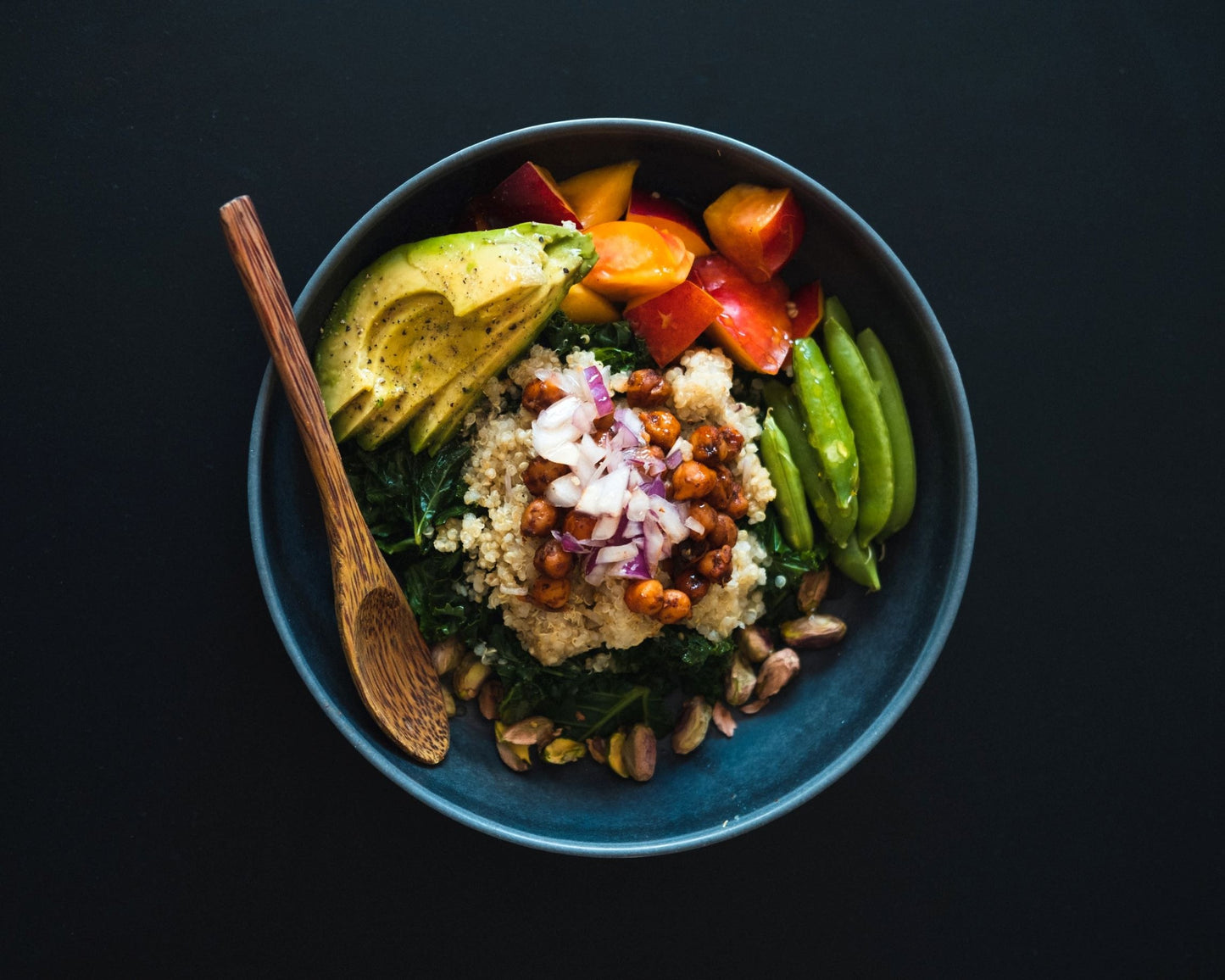
If you’ve ever thought about incorporating more vegetarian dishes into your diet or making the leap to go vegan, you’re onto something. Studies continue to show that balanced plant-based diets—or those that include plenty of plant-based foods—bring about a life-changing host of health benefits. And believe it or not, going vegan can be completely painless.
The Benefits of a Plant Based Diet
Diets that regularly incorporate plenty of plant-based foods have been proven to make substantial positive impacts on health conditions that have become common, like heart disease, diabetes, and obesity. But improving health—and even protecting against disease—isn’t all a more plant based or vegan diet can do:
It’s great for your mental health.
Studies show that vegetarians experience fewer symptoms of depression, stress, anxiety, and mood imbalances than their meat-eating counterparts. The results of one large study showed that not only did individuals suffering from depression experience immediate well-being after consuming fruits and vegetables, but the more they ate, the happier they felt.
It’s great for your weight.
On average, vegans weigh 30 pounds less than meat-lovers, and have a BMI measurement five units lighter. It’s a well-known fact that higher BMI levels are linked to greater incidence of heart disease, diabetes, and other health issues.
It can help you live longer.
Numerous long-term studies indicate that vegans live longer by an average of nearly eight years. Additionally, for every three percent calorie increase from plant proteins, the risk of death is slashed by 10%.
It’s great for the environment.
Approximately one-fifth of greenhouse gasses produced by humans come from farming meat; in fact, opting for an 8-ounce steak is the greenhouse gas equivalent of driving your car 14 miles. Vegan diets, on the other hand, have the lowest carbon footprint; even going vegetarian a few days a week makes a big different to the planet.
Reaping the Benefits—Top Tips to Help You Go Vegan
The benefits are high, and thanks to greater awareness and food accessibility, now is the perfect time to adopt a vegan or simply more plant-based diet. It’s not hard, and these tips will help you enjoy a healthy new way of life!
1. Get informed.
Did you know that not all marshmallows, chocolate, beer or wine are vegan-friendly? Or that most Worcestershire sauce contains anchovies? A little homework is all that’s needed to get informed about what foods are a go and which are a no for your vegan lifestyle. Aside from meat, poultry and fish, dairy products and eggs aren't allowed on a vegan diet. Even foods like bread, pasta and veggie burgers are tricky because they might contain eggs or dairy.
No matter what, you should always read the ingredients list on a product and/or look for a vegan symbol on it.
It’s also important to understand what makes a good vegan diet versus a bad one. Just because pasta and breakfast cereal don’t contain animal products doesn’t mean you’ll benefit from a vegan diet. Not only that, but a diet that isn’t balanced (e.g. empty calories) won’t provide the complete range of nutrients you need—which brings us to tip two:
2. Understand what a balanced vegan diet looks like.
Some people mistakenly believe vegan diets don’t provide the full range of nutrition the body needs, but that’s a myth. A balanced vegan diet will provide you with all the proper nutrients you need, so it’s essential to understand what a well-rounded vegan diet looks like. Start by exploring what nutrients vegan diets can frequently lack (Vitamin D, calcium, omega 3s, and B12 top the list) and then plan meals that adequately address the body’s needs for these nutrients. Your diet should consist of a wide array of vegetables, fruits, legumes, grains, and seeds, among other options. You may need to incorporate a supplement to fully address your Vitamin D and B12 needs, and that’s OK. While planning meals, make sure to fill the nutritional “holes” created by removing non-vegan foods like milk and beef. How will your diet compensate for all that dairy—and calcium—you enjoyed? This is where your homework comes in! (Hint: plenty of dark, leafy greens will do the trick.)
3. Get to know vegan-friendly proteins
Saying sayonara to animal products means you’ll now utilize plant-based foods to address the body’s need for complete protein, iron, and Omega 3s. By getting to know good, quality sources of plant-based proteins, you’ll be able to prepare meals that adequately provide these essential nutrients. Beans, nuts, seeds, whole grains, legumes, and plant-based protein powders should top your list.
You can also use (in moderation) a few of the increasingly many vegan alternatives showing up on store shelves like plant-based burgers, nuggets, cheese, milk, seafood, eggs and even ice cream!
Enjoying a wide variety of alternate protein sources also means you’ll fully compensate for nixed animal-based amino acids.
4. Start small
While switching from meat to meatless may seem overwhelming, you can make it more manageable by starting with small changes. Habits, even healthy ones, take time to stick. Taking baby steps instead of making a drastic dietary change overnight means you’ll be less likely to ditch your new meatless lifestyle. To succeed in your healthy goals, start by going meatless once a week. As you feel more comfortable, gradually increase the number of meatless or vegan meals you enjoy per week. Go at the pace you (and your body!) feels comfortable with, and before you know it, you won’t be missing meat at all.
5. Focus on what you can eat, not on what you can’t
Constantly daydreaming about the hamburgers you won’t be eating isn’t going to help your transition to a healthy vegan lifestyle. Instead, think about the huge variety of foods you’ve discovered during your vegan research. There’s an exciting world of possibility and creativity that’s not only delicious, but incredibly good for your body (not to mention, veggie burgers are pretty darn good!). By experimenting with new recipes and learning new substitutions, you’ll be less likely to focus on foods you’ve decided to cut.
6. Find a vegan support group or buddy
You don’t need to explore a vegan lifestyle on your own! Connect with other vegans who can help you stay motivated as you make the transition to meatless. Online support groups, local vegan cooking classes, and vegan friends can help you glean ideas, tips, and recipes. You’ll also learn about what works and what doesn’t from like-minded people who will help you fully enjoy your healthy new lifestyle.
7. Keep an open mind
Veganism offers plenty of opportunities to explore exciting new food experiences, so stay open! Try new foods and recipes every week—vegan doesn’t mean foregoing hearty or satisfying, but caring for your body in delicious new ways. Tex Mex Vegan Chili? Yes, please! Keeping an open mind also means realizing that faux cheese isn’t going to taste just like Cheddar, and tofu isn’t going to be mistaken for beef in a blind taste-test. Acknowledging and accepting that just means you’ll be open to new possibilities!
8. Go ahead—go out!
Thanks to the increasing awareness of vegetarian and vegan lifestyles, more and more restaurants are not only offering meatless options, but expanding their menu with delicious vegan offerings—and not just in the “salad” section. Don’t be afraid to ask the server if you can substitute or skip certain ingredients, either. Check out the menus of restaurants in your area before a night out to see which offer the best options. There may even be a vegan-only restaurant nearby! Whether you choose to become completely vegan or transition to a few vegan or vegetarian days a week, you’ll see the difference this deliciously healthy lifestyle will make in your mind and body!
Written By: Jill Overmyer
Reviewed and Edited By: Scarlett Full, in-house Registered Dietitian
